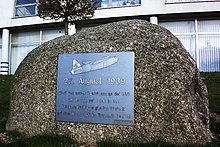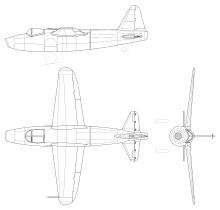| Revision as of 21:26, 28 December 2015 edit.45Colt (talk | contribs)Extended confirmed users1,759 edits →SignificanceTags: Mobile edit Mobile web edit← Previous edit | Revision as of 21:39, 28 December 2015 edit undo.45Colt (talk | contribs)Extended confirmed users1,759 edits →Significance: "430mph" for a Gloster Meteor? "No faster than piston engine fighters"? This is either vandalism or some is confusing it with the Bell prototype from the US. That aircraft barely broke 400mph, and was "barely faster than existing pist...Tags: Mobile edit Mobile web editNext edit → | ||
| Line 48: | Line 48: | ||
| In mid September 1939, two weeks after Germany started World War II, the German air force ordered aircraft manufacturers to reduce development work and concentrate all efforts on winning what German officials expected to be a short war. But the development of jet powered single-seaters was ordered to continue, to get such aircraft operational as fighters as soon as possible.{{Sfn | Koehler | 1999 | pp = 160 note 36, 174 note 78 | ps =: LC2 Nr. 632/39 g.Kdos vom 12. September 1939 Bundesarchiv-Militaerachiv (BA-MA) 4406-812.}} | In mid September 1939, two weeks after Germany started World War II, the German air force ordered aircraft manufacturers to reduce development work and concentrate all efforts on winning what German officials expected to be a short war. But the development of jet powered single-seaters was ordered to continue, to get such aircraft operational as fighters as soon as possible.{{Sfn | Koehler | 1999 | pp = 160 note 36, 174 note 78 | ps =: LC2 Nr. 632/39 g.Kdos vom 12. September 1939 Bundesarchiv-Militaerachiv (BA-MA) 4406-812.}} | ||
| In July 1944, both the German and British air forces began flying jet powered fighters operationally. The British ] F.I, powered by ] centrifugal-flow turbojets, had a maximum speed (in level flight) of |
In July 1944, both the German and British air forces began flying jet powered fighters operationally. The British ] F.I, powered by ] centrifugal-flow turbojets, had a maximum speed (in level flight) of 600mph.<ref name = Mondey1>{{Citation | title = The Hamlyn Concise Guide to British Aircraft of World War II | editor-first = David | editor-last = Mondey | publisher = The Hamlyn Publishing Group, Aerospace Publishing | place = London | year = 1982 | ISBN = 0-600-34967-5 | page = 121}}.</ref> This was about 200mph faster than the best piston engined Allied fighters being flown in combat at that time. The German Messerschmitt ], powered by ] axial-flow turbojets, had a maximum speed of {{convert|870|km/h|abbr=on}},<ref name = Mondey2>{{Citation | title = Concise Guide to Axis Aircraft of World War II | editor-first = David | editor-last = Mondey | publisher = Temple Press, Aerospace Publishing | place = London | year = 1984 | ISBN = 0-600-35027-4 | page = 188}}.</ref>—{{convert|178|km/h|abbr=on}} faster than the best piston-engined fighters—and with superior climb performance. However, the German jet engines had a service life of about 25 hours due to the shortage of heat-resistant steel alloys, whereas the British jet engines could run for 180 hours. The '']'' flew the Me 262 in combat as an air-superiority fighter. The ] used the Gloster Meteor for intercepting ], coastal patrols and for training, where its ability to reach speeds of over 500 mph could simulate attacks by German jets. | ||
| ==Specifications== | ==Specifications== | ||
Revision as of 21:39, 28 December 2015
| This article includes a list of general references, but it lacks sufficient corresponding inline citations. Please help to improve this article by introducing more precise citations. (August 2011) (Learn how and when to remove this message) |
| He 178 | |
|---|---|

| |
| He 178 replica at Rostock-Laage Airport | |
| Role | Experimental prototype/Pioneer aircraftType of aircraft |
| Manufacturer | Heinkel |
| First flight | 27 August 1939 |
The Heinkel He 178 was the world's first aircraft to fly under turbojet power, and the first practical jet aircraft. It was a private venture by the German Heinkel company in accordance with director Ernst Heinkel's emphasis on developing technology for high-speed flight. It first flew on 27 August 1939, piloted by Erich Warsitz. This flight had been preceded by a short hop three days earlier.
Development
In 1936, a young engineer named Hans von Ohain had taken out a patent on using the exhaust from a gas turbine as a means of propulsion.
He presented his idea to Ernst Heinkel, who agreed to help develop the concept. Von Ohain successfully demonstrated his first engine, the Heinkel HeS 1 in 1937, and plans were quickly made to test a similar engine in an aircraft. The He 178 was designed around von Ohain's third engine design, the HeS 3, which burned diesel fuel. The result was a small aircraft with a metal fuselage of conventional configuration and construction. The jet intake was in the nose, and the aircraft was fitted with tailwheel undercarriage. The main landing gear was intended to be retractable, but remained fixed in "down" position throughout the flight trials.
The high-mounted wooden wings had the characteristic Günter brothers elliptical trailing edge. Photos showing a "straight wing" (straight-line-taper in the wing planform, for both the leading and trailing edges) were of the second prototype He 178 V2, which never flew under power.
The aircraft made its maiden flight on 27 August 1939, only days before Germany started World War II by invading Poland. The pilot was Erich Warsitz, who had flown the world's first rocket powered airplane, the Heinkel He 176, on its maiden flight in June 1939, only months before.
The aircraft was a success; however, speeds were limited to 598 kilometres per hour (372 mph) at the proposed service altitude, and combat endurance was only 10 minutes.
Heinkel had developed the turbojet engine and the testbed aircraft, the Heinkel He 178 V1, in great secrecy. They were kept secret even from the German air force and the Reichsluftfahrtministerium. On 1 November 1939, after the German victory in Poland, Heinkel arranged a demonstration of the jet to officials. Herman Goering, commander in chief of the Luftwaffe, didn't even show up. Ernst Udet and Erhard Milch watched the aircraft perform, but were unimpressed. Nevertheless, Heinkel was undeterred, and decided to embark on the development of a twin-engine jet fighter, the He 280 as a private venture using what had been learned from the He 178.
The He 178 V1 airframe was placed on display at the Berlin Air Museum, where it was destroyed in an air raid in 1943.
Significance

Ernst Heinkel was disappointed by the lack of official interest in his private-venture jet. In his autobiography, he attributes this to the failure of the leaders of the Reichsluftfahrtministerium to understand the advantages of jet propulsion and what breakthrough the He 178 represented. In fact, the Reich Air Ministry was already developing its own jets, a fact unknown to Heinkel.
In 1939, BMW and Junkers were working on "official" turbojet engines (in bearing RLM-issued "109-0xx" design numbers) for the German military. These were axial-flow turbojets, which promised much less drag than the centrifugal-flow turbojets like those being developed at Heinkel and by Frank Whittle in England.
In mid September 1939, two weeks after Germany started World War II, the German air force ordered aircraft manufacturers to reduce development work and concentrate all efforts on winning what German officials expected to be a short war. But the development of jet powered single-seaters was ordered to continue, to get such aircraft operational as fighters as soon as possible.
In July 1944, both the German and British air forces began flying jet powered fighters operationally. The British Gloster Meteor F.I, powered by Rolls-Royce Welland centrifugal-flow turbojets, had a maximum speed (in level flight) of 600mph. This was about 200mph faster than the best piston engined Allied fighters being flown in combat at that time. The German Messerschmitt Me 262, powered by Junkers Jumo 004 axial-flow turbojets, had a maximum speed of 870 km/h (540 mph),—178 km/h (111 mph) faster than the best piston-engined fighters—and with superior climb performance. However, the German jet engines had a service life of about 25 hours due to the shortage of heat-resistant steel alloys, whereas the British jet engines could run for 180 hours. The Luftwaffe flew the Me 262 in combat as an air-superiority fighter. The RAF used the Gloster Meteor for intercepting V-1 flying bombs, coastal patrols and for training, where its ability to reach speeds of over 500 mph could simulate attacks by German jets.
Specifications


General characteristics
- Crew: One
Performance
Armament
No installed weapons or hard-points
See also

Aircraft of comparable role, configuration, and era
Related lists
- List of World War II military aircraft of Germany
- List of military aircraft of Germany
- List of Luftwaffe aircraft prototype projects during World War II
- List of jet aircraft of World War II
References
- Koehler 1999, p. 173.
- Koehler 1999, pp. 174–5.
- Smith & Kay 1972, p. 292.
- Thorwald, Jürgen, ed. (1953), Ernst Heinkel: Stuermisches Leben (in German), Stuttgart: Mundus, DNB 451925130.
- Christopher, John. The Race for Hitler's X-Planes (The Mill, Gloucestershire: History Press, 2013), p.59.
- Koehler 1999, pp. 160 note 36, 174 note 78: LC2 Nr. 632/39 g.Kdos vom 12. September 1939 Bundesarchiv-Militaerachiv (BA-MA) 4406-812.
- Mondey, David, ed. (1982), The Hamlyn Concise Guide to British Aircraft of World War II, London: The Hamlyn Publishing Group, Aerospace Publishing, p. 121, ISBN 0-600-34967-5.
- Mondey, David, ed. (1984), Concise Guide to Axis Aircraft of World War II, London: Temple Press, Aerospace Publishing, p. 188, ISBN 0-600-35027-4.
Bibliography
- Koehler, H Dieter (1999), Ernst Heinkel – Pionier der Schnellflugzeuge, Bonn: Bernard & Graefe, ISBN 3-7637-6116-0.
- Smith, JR; Kay, Antony L (1972), German Aircraft of the Second World War, London: Putnam, ISBN 0-85177-836-4.
- Warsitz, Lutz (2009), The First Jet Pilot – The Story of German Test Pilot Erich Warsitz, England: Pen and Sword, ISBN 978-1-84415-818-8.
External links
- Erich Warsitz (official website), including rare videos of the Heinkel He 178 and audio commentaries.
| Heinkel aircraft | |||||
|---|---|---|---|---|---|
| Company designations pre-1933 |
| ||||
| RLM designations 1933–1945 |
| ||||
| Projects 1933–1945 | |||||
| Foreign designations |
| ||||